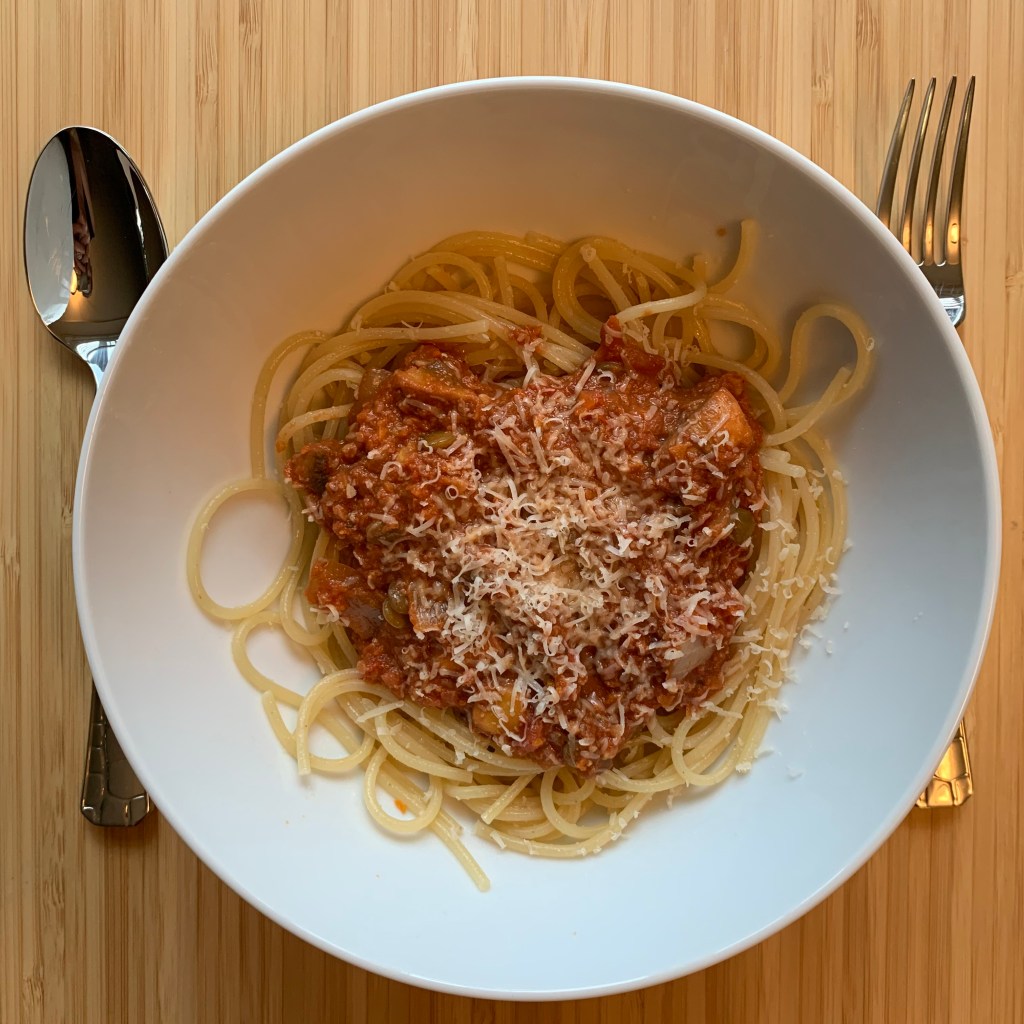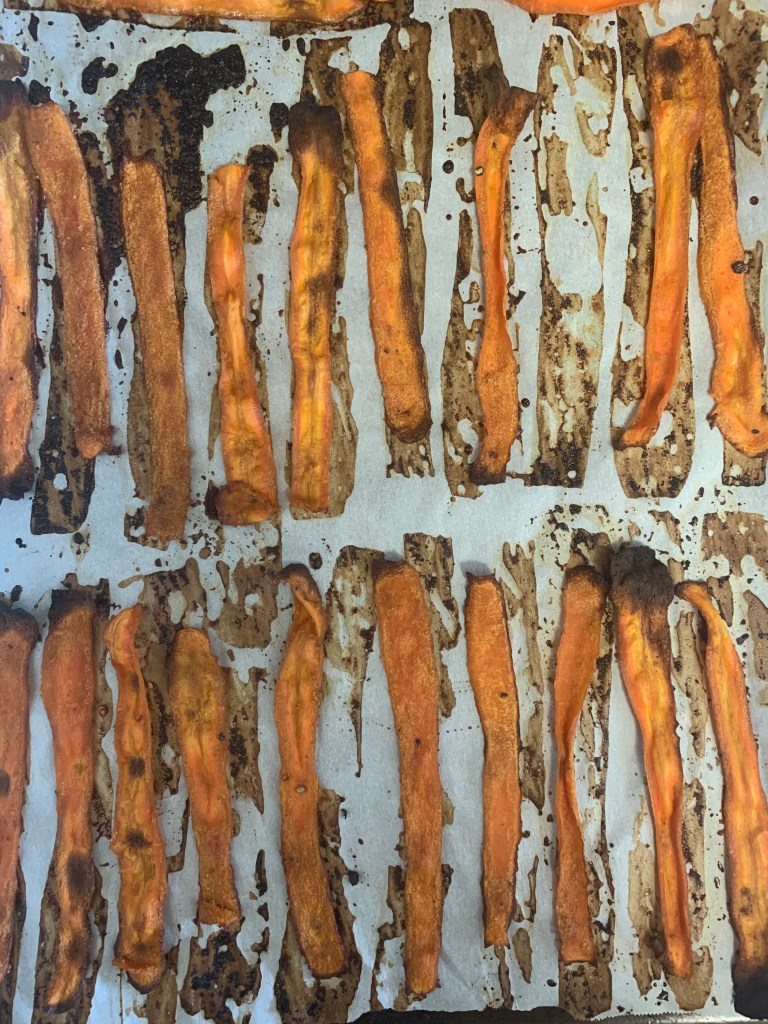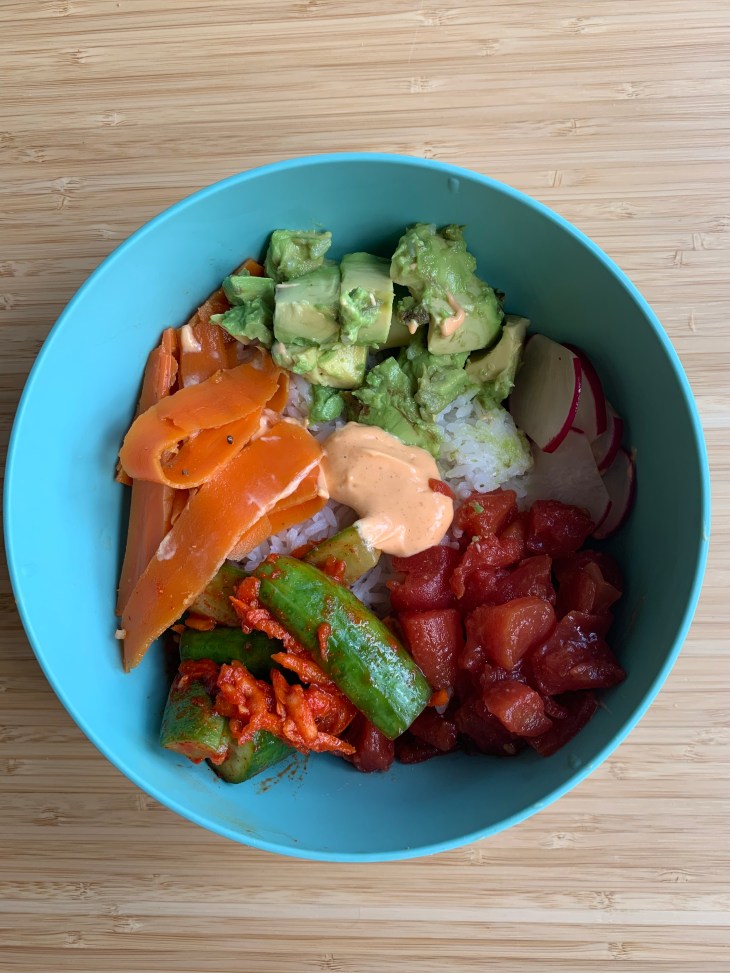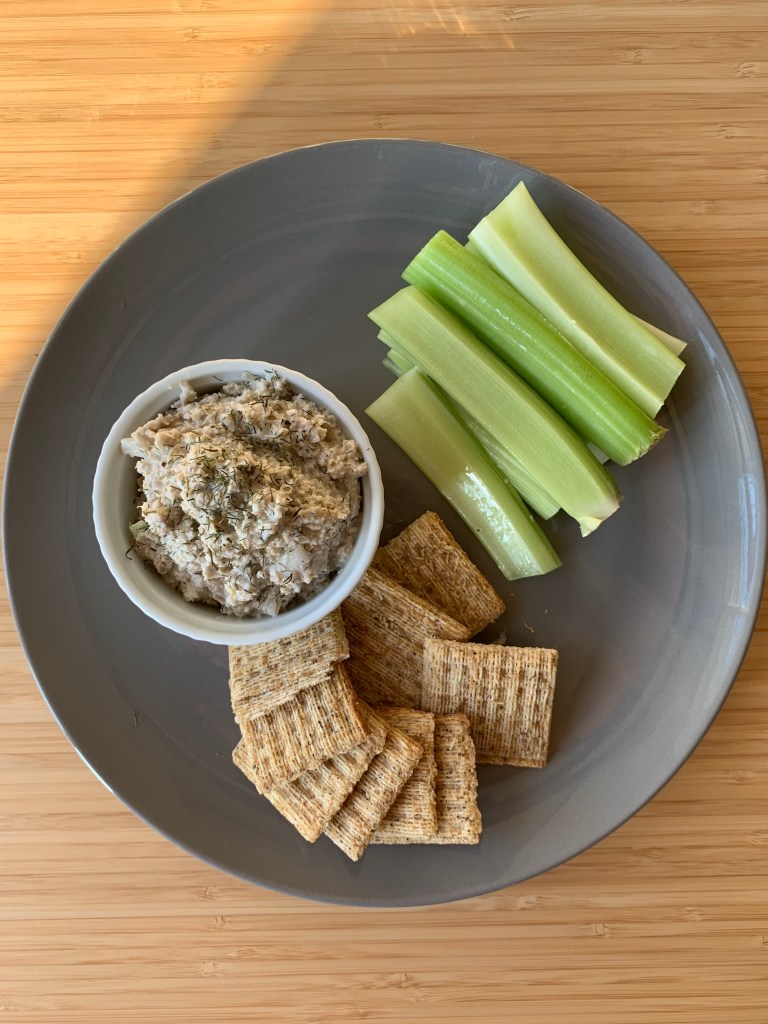Over the past couple years, I have been trying to consume less meat. I grew up like many of you did where meat made it on the plate breakfast, lunch, and dinner. And although I don’t think I will ever go full vegetarian or vegan, I’ve learned to love meals without animal protein just as much as with. If you’re curious, I try to eat less meat because it default pushes me to eat more vegetables (if I stick with the mindset and dishes I’ll explain below) and I truly believe we should know where our food comes from, so I try to avoid buying meat and other animal products from chain grocery stores as much as possible.
Like many other habit changes, veganism and vegetarianism used to feel like an all or nothing effort. You mess up once, and you might as well get in the line at McDonald’s. Luckily, people now realize that they can give up animal products some and still help the environment and the treatment of animals. It’s more likely for ten of us to cut out meat a few nights a week than one of us going vegan, and we are still helping, right? At least that’s the way I see it.
Many times when people decide to eat less meat, they will try to find meat substitutes, realize it doesn’t quite give them that meatiness that they wanted, then they give up. I’ve always tried to take the approach of finding dishes that are already vegetarian or vegan friendly and eat those. That’s why I eat a lot of Indian and Southeast Asian dishes. Tofu, lentils, and beans have been a big part of my diet over the past few years. I don’t love the idea of eating vegan cheeses and meats that are full of fillers to help mimic taste and texture (not all do, but many do). So I wanted to share some recipes that might not be on your radar: veggie-forward meat substitutes. They’ll make you feel good all around: no animal protein AND no weird preservative and fillers. Some of these subs aren’t protein-packed (except the ones with nuts), but I think you can find ways to add protein in your diet elsewhere. Up for the challenge?
Most of the dishes in this post are made from fresh vegetables and easy to find, but if you think less meat is a direction you want to move more towards, I recommend you purchase some of the following. Most will be easy to find at health-forward grocery stores. And like all my food posts, I suggest seasoning the recipes below and having a good amount of spices, sauces, and vinegars on hand to improve your cooking and make more satisfying food.
- Nutritional yeast. Good cheese substitute, usually used to sprinkle on dishes, but I’ve seen melted queso recipes with it. Read all about it in my post here.
- Seaweed: Kelp powder/granules. It’s what will give any seafood substitute a really nice seafood flavor. I was skeptical too, but I’m a big fan. Asian grocery stores will have a huge selection of seaweed (do a little research beforehand to know what you need), or you can easily find on Amazon. Amazon tends to be a little more expensive.
- Canned jackfruit. Perfect pulled meat texture, needs a little love to chill out the sour flavor, but it’s so worth it. Health food stores and Asian grocery stores both carry. I usually get mine from Trader Joe’s.
- Liquid smoke. You should be able to find this at most grocery stores, either in the spice or sauce section. A little goes a long ways.
- Walnuts. Good meaty texture, without the overpowering nuttiness of peanuts. Go with raw (to control salt) and baking pieces (to save a few bucks).
- Sun-dried tomatoes, just a big hit of both tomato flavor and subtle meatiness/umami.
- Artichokes, canned or jarred. Artichokes have a nice, meaty mouth feel, good for many Mediterranean dishes.
- Balsamic vinegar, easy umami flavor to add.
- Lentil, beans, etc. Protein, protein, protein.
- Tofu, duh. If you don’t buy tofu a lot, go with firm. It gives you the meat texture you want. Although, I love silken tofu, it isn’t as versatile.
- Mushrooms, fresh or dried. Flavor and texture can easily be manipulated into meatiness.
- Spices, spices, and more spices.
Here are the recipes I’ll go over for the veggie-forward meat substitutes. If you want to see how I used most of these recipes in my weekly meal plan, check out this post.
- Walnut + Lentils for bolognese sauce
- Cauliflower + Walnuts for ground beef for taco meat
- Baked and marinated carrots for bacon
- Carrots for smoked salmon
- Seasoned tomatoes for raw tuna
- Jackfruit for pulled pork or chicken (chicken melt sandwich and Cuban)
- Sunflower seeds for canned tuna
I ranked each recipe by 1. Ease; 2. Flavor, both in general and as a meat substitute; 3. Texture, in general and as a meat substitute. Anything over a 5 meets my standards. Anything over an 8, I was really impressed with. Here are my thoughts on the meat substitutes:
Ground Beef:
Walnut + Lentils + Mushrooms for a Vegan Bolongese Sauce. I went off of this recipe. I didn’t use zucchini because I didn’t have any at home, but I don’t think I missed out. The look of the sauce was pretty impressive, and besides the bits of lentils, I thought it looked a lot like a meat sauce. Speaking of the lentils, if you’re not a huge lentil person and aren’t needing the protein from them, I might leave out. I thought it gave the sauce an unnecessary texture and I would probably use a chickpea pasta next time, or other protein-heavy pasta, if I was wanting more protein to this dish. I thought the carrot gave a surprisingly good texture. It is worth noting that if you don’t have a food processor or blender, I think it would be too difficult to get the correct texture for the carrots and walnuts.
The meat sauce definitely shouldn’t be the star of the meal. Make sure you have enough pasta and tomato sauce to balance it. I made this mistake and definitely started to notice the grit from the walnuts towards the end of my bowl. I used the bolognese sauce for lunch the next day and spread it onto some toast. The extra day really softened the walnuts and brought the flavors together. I wouldn’t have guessed it wasn’t a normal bolognese sauce. So moral is: cook it longer or know that it’ll be better the next day. Overall, it was a really simple recipe to get you started on some easy vegetarian recipes. Ease: 8.0; Flavor: 6.7; Texture: 6.8 (the next day)

Walnuts + Cauliflower for Vegan Taco Meat. I went off this recipe. I used this taco meat for a burrito bowl, and while the bowl was actually really delicious, I don’t think I pulled off the recipe well. Several other recipes said to process the veggies and nuts separately, but this recipe did not. I can see why the other recipes wanted them to be done separately. My blender (I own a Ninja) made the bottom part too pasty and left some of the cauliflower in bigger bits. The flavor of the walnuts shined through a lot more than in the bolongese sauce. I like the taste of walnuts, but if you’re really going for a meat substitute, that flavor might throw you off. I saw other recipes use pepita (pumpkin seeds) and I’m wondering if that’s why.
I love the taste of cauliflower, but I don’t tend to love it as a carb sub so I questioned if I would like it as part of a meat substitute. The smell of the cauliflower in the oven definitely made me pessimistic about this recipe. However, once it came out and I put it with rice, beans, and avocado, I totally forget it was cauliflower. If this recipe interests you but it wasn’t amazing the first try, I think it’s something you need to make a few times to perfect. Ease: 5.5; Flavor: 7.0; Texture: 6.2

Bacon:
Carrots, cut into thin strips with the proper marinade, and baked or air-fried supposedly replicate bacon. I first saw this idea on Tabitha Brown’s Instagram and later found this recipe to try out. I don’t have an air fryer, so I baked the carrots at 400F. I had already made the smoked ‘salmon’ carrots below and the prep was a very similar process. If you have a decently sharp vegetable peeler, you get the hang of creating nice carrot ribbons fairly quickly. Also, the ribbons are pretty thin, so even 2-3 carrots make way more bacon (or smoked salmon) than probably what you would initially guess.
I cooked the carrots for 15 minutes. They were burning before they got crisp everywhere. Otherwise I would have let them go another five minutes. These were very good carrots and pretty bad bacon. The author of the recipe I used even said the best option is the air fryer. My oven never gave them the crisp they needed, so give it a shot in your air fryer but this one didn’t work out in the oven. I ended up piling them high on an egg sandwich and the sandwich was great, but it tasted like I had really flavorful veggies under the egg, not bacon. There’s definitely potential here, so I don’t want to say this idea is a flop. Making the carrots thicker (I think the thinness is what made the ends burn before everything cooked through) would probably help. But I will need to come up with some other methods or buy an air fryer to make it work. Ease: 6.5; Flavor: 7.5; Texture: 4.1

Salmon, Smoked:
I found a surprising amount of mock-salmon recipes and tried several to see which I liked the most. I had smoked “salmon” using carrots and cream cheese bagel at this cute cafe, Red Cup, in Oklahoma City and that’s what I hoped to recreate. This recipe I found was surprisingly not that complicated. I chose to steam the carrots to better control the texture, peeled them into thick-ish ribbons with a vegetable peeler, and soaked them in an easy marinade overnight. I made three carrots worth and ended up eating them all. I put on top of bagels and added them to the poke bowl that I’ll explain below. Ease: 6.5; Flavor: 8.9; Texture: 7.8

Tuna, Spicy & Raw:
Spicy tuna is my favorite raw fish for a nice poke bowl, so when I saw a recipe for it using tomatoes, I was pretty excited. I’m pregnant and it’s hot out, so I’ve been really missing a nice poke bowl. This is the recipe I used, and although it is tomato season, I wanted to simplify this recipe even more, so I used a can of drained diced tomatoes. I marinaded the tomatoes overnight and served them cold with warm rice, vegan lox from above, srichacha mayo, and lots of other goodies. Overall, this was my favorite recipe. It was super easy and had the most realistic taste and texture to meat. I think raw tuna is wonderful for you, but it’s nice being able to enjoy this while pregnant and to easily and confidently make a poke bowl at home. Ease: 9.1; Flavor: 9.2; Texture: 8.7

Pulled Pork or Chicken:
Jackfruit, as a ripe fruit, is floral and delicious and one of my favorite fruits. I tell people it has the texture of a really thick rose petal; the perfect bounce in texture without being chewy. Underripe jackfruit is now popular as a meat alternative. I buy it in a can with some brine, then chop it up and mash a little bit of it with my hands; and just like that it *looks* just like pulled pork or chicken. I’ve had underripe jackfruit turned faux shredded meat at restaurants several times and really love it. I bought a pre-marinated pack once and it was a total flop and I sauteed a can of it once as sort of a fajita mix with veggies, and again ehh. So I tried this recipe and this recipe in hopes to making something restaurant worthy. The first recipe makes a faux Tuna Melt, but I’m angling it more as a chicken melt by leaving out the kelp granules that give it an ocean taste. The second recipe is a Jackfruit Cuban. You can also try jackfruit with barbecue sauce or as a faux pulled pork taco or or in a quesadilla. If you can’t tell, jackfruit is probably my favorite produce-turned-meat substitute when made properly. However, even after giving jackfruit another go at home, it was still a learning curve. Here’s what I learned.
Although I rinsed the jackfruit before adding it to the sauces, I thought it still had too much tang (coming from a girl who loves everything sour). The Cuban recipe I used included orange and lime juice. Combine that with pickles and mustard, I was worried it was going to turn into a sour mess. I ended up sprinkling some brown sugar on the jackfruit and cooking for longer and that really seemed to balance the flavors out. But in general, just know that the jackfruit might taste a little too sour alone. To balance out this acidity, go with something sweet or something dairy. These alkalinic ingredients cut through the acidity and create a better balanced flavor. Once I paired the jackfruit with bread and cheese (and some brown sugar in the Cuban recipe), it tasted so wonderful. But it wasn’t something I would pop in my mouth alone the way I would some good barbecue pork.
Next, the texture was off in both recipes until I really turned up the heat. Broiling the jackfruit, like suggested in the first recipe, created the crisps and crunch that the jackfruit needs to really embody meat. When I’ve sauteed jackfruit in the past, I realized this was the main thing I was doing wrong. It needs something to develop some char. The Cuban recipe I used said to bake for 30 minutes. I think I ended up going for 45 minutes. Maybe I enjoy slightly burnt crisp more than others, but I think going a little longer to give the jackfruit a more BBQ style texture is worth it. Both these recipes were meant to be for lunch, but as I would expect a good pulled pork recipe taking longer than 15 minutes, these too were not quick recipes to whip up. Lastly, next time I’m going to try rinsing the jackfruit after I’ve chopped it to hopefully help reduce the sourness that might be from the brine. I’m not giving up on you, jackfruit. Ease: 4.1; Flavor: 6.8; Texture: 8.5

Tuna, Canned:
Canned tuna in general hasn’t been something I normally crave, but every once in awhile, a simple tuna salad can really hit the spot. I usually keep a couple packages or cans of tuna in my pantry and have the remaining ingredients always available. It’s one of those protein-packed five minute lunches that we all need in our recipe arsenal. I found a recipe using sunflower seeds, soaked for 24 hours, as both the meat substitute and the creamy (mayo) substitute. Although, it’s not the 5 minute lunch I’m used to, I was quite happy with this recipe.

I followed this recipe, soaking the sunflower seeds for 24 hours, pulsed them in my blender, and added the other ingredients. I also added some extra dill on top and did add about a tablespoon of mayo because I wasn’t trying to keep it vegan. This would be great with some toasted bread, but I just cut up some extra celery and also served with crackers. I used kelp granules to make the dish have a sea taste. But if you don’t like that fishy flavor, then this might be an even better recipe for you since you can just leave it out. In general, I thought this is both one of the healthier alternatives I made and one of the simplest, besides it taking some prep time. Ease: 5.9; Flavor: 8.8; Texture: 7.5
While I was writing this post throughout the week, it gave me some time to think about what recipes I plan on trying again and what I didn’t really miss. So here’s how I rank everything I made over the past two weeks and how likely I would make it again.
- Spicy ‘Tuna’ Tomatoes
- Carrot Lox
- Sunflower Seed ‘Tuna’ Salad
- Jackfruit Chicken Melt
- Jackfruit Cuban (mostly scoring lower because I didn’t like the sauce in this recipe)
- Carrot Bacon (my initial try kinda sucked, but I want to give this concept more tries)
- Vegan Bolognese Sauce
- Vegan Taco Meat
And here are some other veggie-forward recipes I want to try:
- Vegan ‘Mussels’ with fries, made with mushrooms
- Vegan Gyros, made with portabello mushrooms or seitan
- Vegetarian Lobster Roll, made with heart of palms
- Vegan Fried Fish, made with artichokes
- Watermelon Poke
- Smoked Salmon, made with red bell peppers
Have you tried anything similar? Any veggie and nut-forward vegetarian recipes you think I should try?
2 thoughts